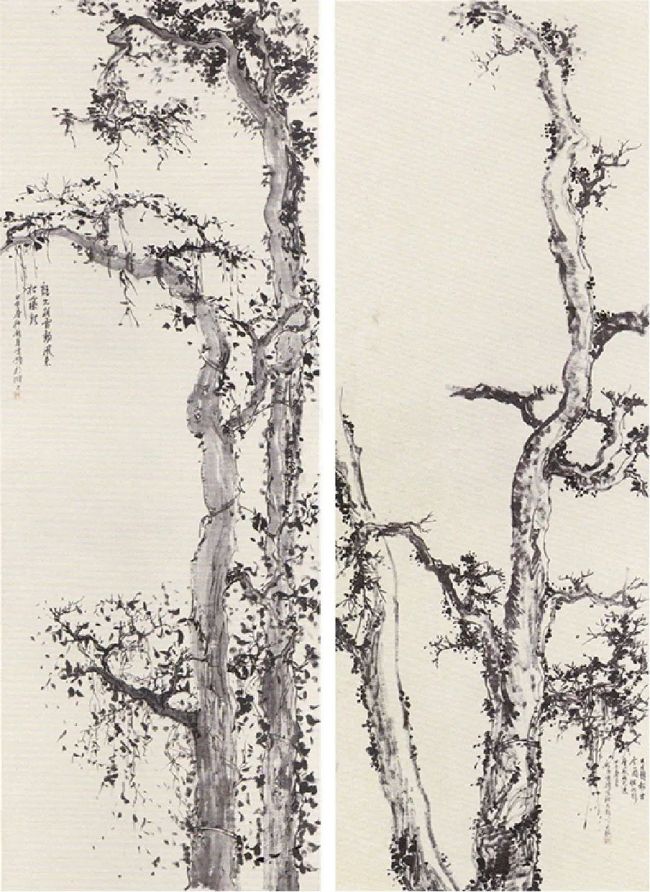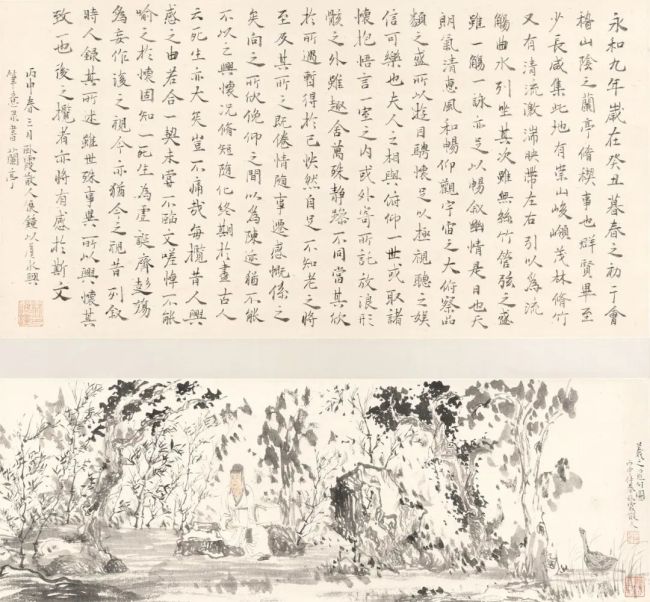In Brushwork Notes, it is said that “wash painting emerged in our Tang Dynasty”, and its using of ink is still viewed as coloring. Lin Haizhong, on this basis combining with the painting theories of the succeeding generations, puts forward the idea that “the brushwork is the ink and the ink is the brushwork”, that is to say, that the use of ink and color also requires the use of the brush. Only by using the brush in the ink can one “blossom in the world of ink”, as Shi Tao said, and his practice has advanced on the basis of Jing Hao’s theory.

一峰独秀图纸本水墨 Ink on paper74.5x32cm2011
III. “Thought and Scene” and “Four Qualities”
In Brushwork Notes, it is said that “thinking is to draw out the main points, and to visualize the form”. The idea is about the subjective choice of the arrangement of the whole piece of work, and about the creation of the conceptual perception. “What so-called scene is to extract the elements of beauty from the scenery in front of you, to study its truth, and to discover its subtleties.” That means to make a thorough inquiry into the pattern of the mountains and rivers, and through the subtleties of the images of things to reveal the truth. Four-quality is meant to clarify the further evaluation standard of “thought” and “scene”: the highest standard is “spirit”, which “has no action, and forms the image in nature”, presenting the concept of becoming of the heavenly way in nature which is in line with the spirit of Taoism. All the becoming of chaotic combination by chance is a kind of natural state of generative movement. It can be understood as the manifestation of the interplay of yin and yang, a kind of pre-established pattern. That “What so-called subtlety is the thought through heaven and earth, all kinds of dispositions, the appearance of texture and pattern, and the schema of things and the flow of the brush”, on the other hand, emphasizes the top-down rational perspective seeing the world in landscape painting. Jing Hao’s detailed discussion of the characteristics of the growth of pine and cypress in terms of the doctrine of Analogies to Virtues, his observations of the biodiversity of rowan, tung, oak, elm, willow, mulberry, and acacia with their different shapes and qualities, and the topography and geology of peaks, tops, ridges, caverns, cliffs, rocks, valleys, streams, and ravines, and the meteorological phenomena of fog and clouds, are all about the empirical content of all things in heaven and earth, showing a respect for objective experience and natural norms, and an observation of the pattern of becoming of all things based on the dichotomy of the body and the image of dispositions, which is characterized by the worldview of Confucianism in the light of heavenly pattern and its manifestation in the landscape. “What so-called strangeness means the unpredictable traces, the possible deviation from the real scene. Those who get strangeness from the biased pattern have a painting without thinking”. In consideration of Jing Hao’s comments on other painters, it can be seen that he attaches importance to “thought” and “pattern”, and the order of the real and theoretical worlds becomes very important, emphasizing the order of naturally becoming and actualization route of landscape painting, and also expressing a certain degree of criticism of the aesthetic of the deviation from the real scene. “What so-called ingeniousness means embellishing, pretending to fit in with the great law, deliberately crafting to depict the image in stacking. This can be said insufficient in content but surplus in prosperity”. His strong disdain for craftsmanship and falsification puts the work’s intrinsic compatibility with the Great Tao in an absolute position. The truth behind the phenomenon is “disposition”, “heavenly pattern”, and “Tao”, which transcend all appearances, and are beyond the reach of all superficial craftsmanship.

枯木龙吟之老龙岭(右)、枯木龙吟之风雪动(左)纸本水墨 Ink on paper217x77cm2014
A later in the Song Dynasty, Guo Xi’s The Heart of Forest and Spring describes the realm of landscapes as follows: “What is the purpose of a gentleman’s love for landscapes? The hill garden is the place where one can cultivate one’s disposition; the spring-rock is the place where one feels free; the fisherman and the woodcutter are who one is always at ease with; the apes and the cranes are what one is always close to. The clamor and constraints of the world are what humankind are always tired of. The immortals and saints are what humankind often wish to see but cannot see. ... However, there are the aspiration to living in the forest-spring and the ideal of being companied with the smoke-haze even in dreams, though ears and eyes are cut off when dreaming. Today’s masters of painting are so interested in painting the beautiful scenery of springs and rocks that they do not have to go out of their halls, but can explore them while sitting in their seats, with the cries of the apes and birds in their ears, and the light of the mountains and the colors of the water brightly shining, so isn’t it pleasing to the human mind and appealing to my heart? This is the original intention of the world to cherish landscape paintings. If you do not cherish them, but treat them with an irreverent heart, are you not confused?”

羲之觅句图纸本水墨 Ink on paper60x65cm2016